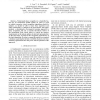130 search results - page 23 / 26 » Mobile robot learning by evolution of fuzzy controller |
IROS
2007
IEEE
14 years 1 months ago
2007
IEEE
Abstract— Vision-based place recognition is a desirable feature for an autonomous mobile system. In order to work in realistic scenarios, visual recognition algorithms should be ...
RAS
2008
13 years 7 months ago
2008
The task of trajectory design of autonomous vehicles is typically two-fold. First, it needs to take into account the intrinsic dynamics of the vehicle, which are sometimes termed ...
SMC
2010
IEEE
13 years 6 months ago
2010
IEEE
This paper presents a method for selection of SIFT(Scale-Invariant Feature Transform) feature points using OC-SVM (One Class-Support Vector Machines). We proposed the method for au...
IJCAI
2007
13 years 9 months ago
2007
The mobile robotics community has traditionally addressed motion planning and navigation in terms of steering decisions. However, selecting the best speed is also important – be...
GECCO
2009
Springer
14 years 5 days ago
2009
Springer
Evolution of neural networks, as implemented in NEAT, has proven itself successful on a variety of low-level control problems such as pole balancing and vehicle control. Nonethele...

